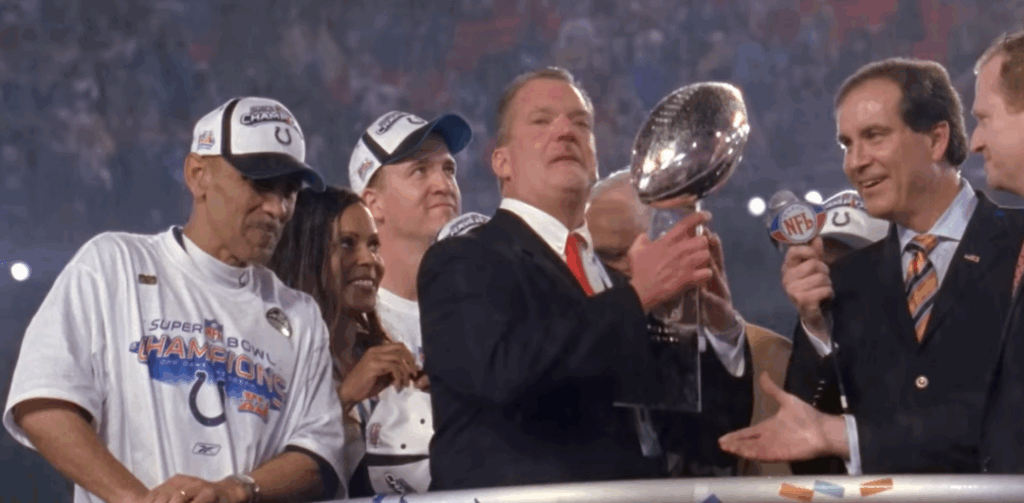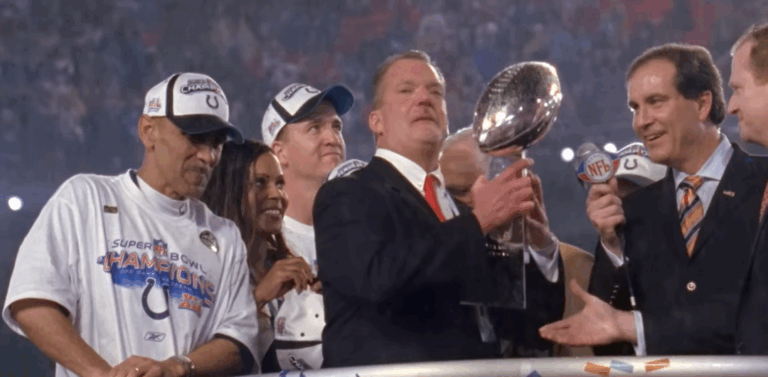Jim Irsay’s health was more than just his medical history; it became a symbol of how his personal struggles had significance outside of the football field. His body was scarred by numerous surgeries, excruciating pain, and severe emotional distress over the years, but his spirit stayed focused on action and purpose. The tale of Jim Irsay’s health issues has now turned into a mirror reflecting the unsaid struggles faced by executives in demanding fields, both for professionals and fans.
His condition had gotten much worse by 2023. He looked weak, frequently helped by hospital-grade equipment—a strange sight for someone who was once known for his vivacious NFL leadership. During a particularly distressing incident, emergency personnel discovered him at home, barely breathing and feeling cold to the touch. Although the official explanation described it as a “severe respiratory illness,” there were rumors that suggested something more complicated—possibly another overdose, continuing a painful pattern.
In a 2023 HBO interview, Irsay himself revealed the brutally honest truth. He described the horrifying experience of overdosing on a mixture of drugs he hardly understood, which rendered him clinically dead until he was brought back to life. That was not an isolated incident. He publicly acknowledged that he had spent “at least 15 times” in rehab. His campaign, Kicking the Stigma, became a national movement that challenged the stigma associated with addiction and mental illness. He did not conceal this past; rather, he embraced it with remarkable candor and used it to fuel something bigger than himself.
Jim Irsay Biography & Health Overview
| Full Name | James Stephen Irsay |
|---|---|
| Born | June 13, 1959 – Passed away May 21, 2025 |
| Age at Death | 65 years |
| Occupation | NFL Owner, CEO of Indianapolis Colts |
| Team Ownership | Since 1997 |
| Major Health Issues | Addiction, Overdose, Respiratory Illness, Surgeries |
| Rehab Stints | Reportedly at least 15 |
| Family | Three daughters: Carlie, Casey, Kalen; 10 grandchildren |
| Notable Campaigns | “Kicking the Stigma” – Mental Health Advocacy |
| Public Struggles | Opioid use, mobility issues, past DUI arrest |
| Reference Link | Men’s Journal – Jim Irsay Health |

Fans have re-examined that quote in recent days: “The doctor said, ‘Jim, you’re one lucky man.'” Tragic irony stings it now. Only months after barely avoiding what appeared to be a fatal collapse, the man who fought so valiantly to live—and to help others live—died in his sleep. Although they were kind in their remembrance, the Colts franchise did not specify the cause of death. That quiet made room for introspection and unease.
Irsay had a long medical history. He had more than two dozen surgeries, mostly for nerve damage, degenerating joints, and a severe hematoma in 2024. He was wheelchair-bound and dependent on helpers for balance and mobility by the time he made his most recent appearance at an NFL event. Although he didn’t talk much about the pain in public, people close to him revealed that he stayed focused and insisted on going to Jim Irsay Band games and performances.
The sharp contrast between Irsay’s external success and internal suffering was what made his health journey remarkably similar to that of other fallen icons. Irsay wore generosity and charm like armor, much like Philip Seymour Hoffman or Robin Williams. He gave millions of dollars to charities, the arts, and mental health initiatives. He put forth great effort to stifle or conquer the silent desperation that frequently simmered beneath that kindness.
Irsay’s illness had a significant symbolic meaning in the world of professional sports in addition to being personal. The NFL has long prioritized wellness initiatives, player injuries, and concussions. However, what about the proprietors? These individuals bear the burden of private demons, public scrutiny, and billion-dollar empires. Irsay became an uncommon exception—an owner who revealed his vulnerabilities, who sought healing in a group setting rather than alone.
Irsay significantly enhanced the conversation around mental health in the NFL’s elite circles by using his notoriety and vulnerability. He established himself as a model, demonstrating that leadership and healing are not incompatible. For executives in comparable roles, his story is especially helpful because it serves as a reminder that, despite its discomfort, openness can be incredibly therapeutic.
However, this also brings up awkward issues. Was there anything more that could have been done? After the emergency in December 2023, should close friends or associates have stepped in sooner? These are reflections that frequently follow a public figure’s untimely death; they are not accusations.
Irsay contributed to the expansion of conversations about mental health outside of locker rooms through strategic alliances and tenacious advocacy. His work broke down barriers and made room for long-overdue discussions. In addition to protecting players’ bodies, the NFL is now under pressure to uphold the memory of a man who battled to protect hearts and minds.
The loss is incalculable for his family. Carlie, Casey, and Kalen, his daughters, thanked the public for their support, but they also made it clear that his legacy is about survival just as much as it is about success. Their father had used a flashlight to guide others through the dark, frequently stumbling himself.
There are lessons in his story that go far beyond football. For example, many professionals in leadership roles experienced mental strain never seen before during the pandemic. Irsay’s life serves as a reminder that being visible does not guarantee immunity. No matter how strong they are, leaders can suffer in silence unless they have the systems in place to fully support them.
Jim Irsay’s influence will go beyond victories and awards. A national conversation concerning addiction, recovery, and the demands made of public figures is reignited by his passing. It challenges organizations to reconsider their conception of strength—not as stoicism, but as the capacity to seek assistance and persevere in the face of suffering.
Irsay’s legacy may change how the NFL handles wellness in the years to come. Discussions regarding regular executive leadership mental health check-ins have already begun. If it were put into practice, it would be a very powerful way to remember a man who demonstrated that being a leader is about displaying your scars, healing them, and assisting others in avoiding them.


